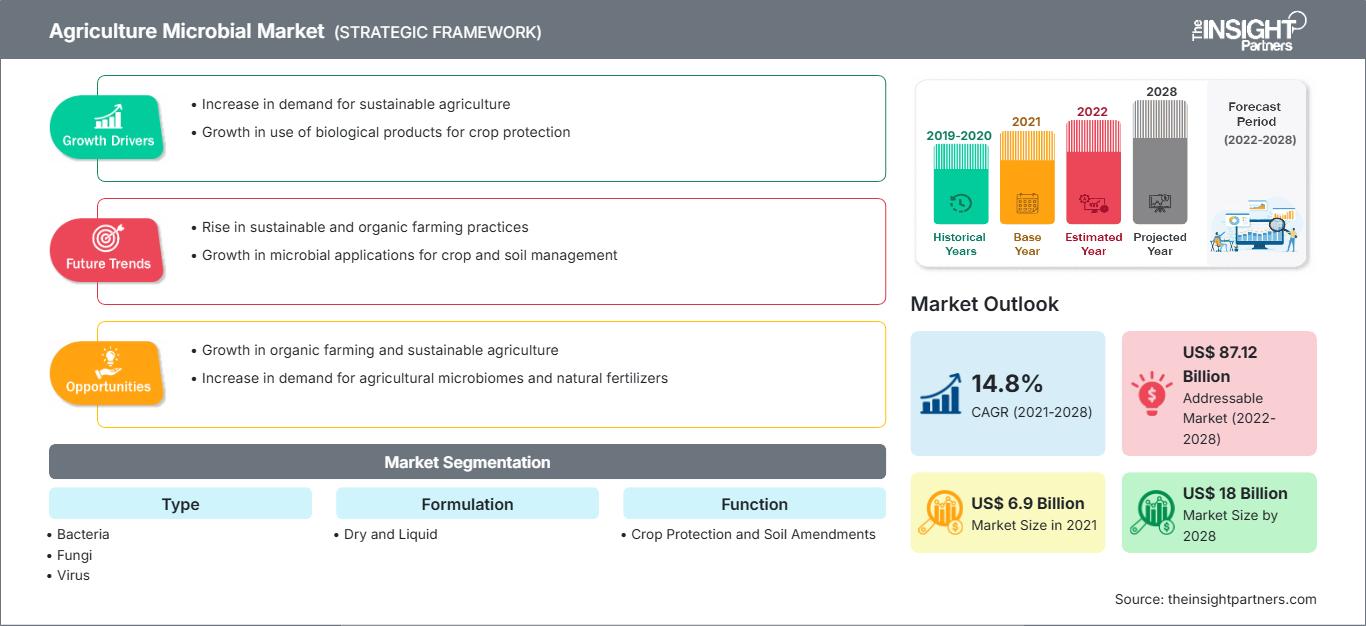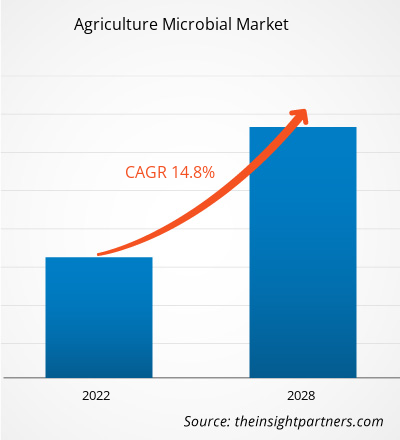Insight Partners 表示,2021 年农业微生物市场价值为 69.0193 亿美元,预计 2022 年至 2028 年的复合年增长率将达到 14.8%。
农业微生物是指在农业中用于提高作物产量和产量质量的微生物。细菌、真菌和病毒是其中几种微生物。它们可以通过改善营养物质的获取来促进植物的生长。许多微生物有助于分解有机物并回收利用农业废弃物。此外,它们还提供磷、氮和其他营养物质,并具有耐热、耐旱、抗虫害等功效。
2020 年,北美占据全球农业微生物市场的最大份额,预计亚太地区在预测期内的复合年增长率最高。由于人们越来越意识到在农业中使用微生物优于合成化学品,北美成为市场最重要的地区之一。合成化学品的使用会变得无效,因为它们会产生抗药性并损害作物产量。农业微生物实用且即使少量使用也能快速分解,从而降低暴露量并防止合成化学品造成的环境问题。
此外,环保和有机农业实践的兴起推动了微生物农业市场的增长。根据美国农业部 (USDA) 2019 年有机调查,2019 年美国共有 16,585 个有机农场,比 2016 年增长了 16.7%。
自定义此报告以满足您的要求
您将免费获得任何报告的定制,包括本报告的部分内容,或国家级分析、Excel 数据包,以及为初创企业和大学提供超值优惠和折扣
农业微生物市场: 战略洞察

- 获取本报告的主要市场趋势。这个免费样本将包括数据分析,从市场趋势到估计和预测。
新冠疫情对农业微生物市场的影响
您将免费获得任何报告的定制,包括本报告的部分内容,或国家级分析、Excel 数据包,以及为初创企业和大学提供超值优惠和折扣
农业微生物市场: 战略洞察

- 获取本报告的主要市场趋势。这个免费样本将包括数据分析,从市场趋势到估计和预测。
在新冠疫情爆发之前,农业微生物市场主要受有机农业普及和可持续农业需求增长的推动。然而,2020年,由于疫情的影响,许多行业面临着前所未有的挑战。由于一些生产单位的关闭和供应链的中断,农业产业出现衰退。然而,在2021年,随着各国政府宣布放宽先前实施的限制措施,各经济体纷纷重启运营,这对全球市场产生了积极影响。此外,制造商被允许满负荷生产,这有助于他们弥补供需缺口。目前,市场形势远好于以往。许多国家都已全面接种疫苗,农业微生物产品制造商正致力于提高产量以增加收入。
由于随后的封锁和商店关闭,生产单位的劳动力短缺以及分销商和零售商的现场销售中断,抑制了农业微生物市场的发展。尽管新冠疫情给农业带来了重大打击,但多家公司报告称,到 2020 年底,该行业对可持续农产品的需求有所增长。然而,由于农产品短缺日益严重,各国政府放松了对农产品的限制,以满足粮食需求。
市场洞察:有机农业应用的兴起推动了农业微生物市场的发展
在过去的几年中,有机农业已在全球范围内被采用,以实现可持续发展并降低对环境的有害影响。减少土壤侵蚀、减少硝酸盐向地下水和地表水中的浸出以及回收农场动物粪便都是有机农业的好处之一。人们对其益处的认识不断提高,从而激增了对有机农业实践的需求。根据美国国家农业统计局 2019 年有机调查显示,2016 年至 2019 年期间,美国获得认证的有机农场数量增加了 17%。根据联合国粮食及农业组织 (FAO) 的数据,2019 年,187 个国家实行有机农业,约有 7230 万公顷农业用地采用有机管理。一些发展中经济体的政府大力强调采用有机农业。农业微生物在有机农业的土壤管理中起着至关重要的作用,因为它们无法被合成成分取代。土壤微生物,包括细菌、真菌和病毒,在土壤中发挥着基本功能,例如分解作物残留物、循环氮和碳等关键营养物质以及刺激植物生长。因此,有机农业的普及推动了对农业微生物的需求,因为它们在有机农业中具有诸多益处。
类型洞察
根据类型,农业微生物市场细分为细菌、真菌、病毒和其他。预计细菌细分市场在预测期内将占据最大的市场份额和最高的复合年增长率。真菌是分解有机物和回收废弃植物材料的重要土壤微生物之一。此外,它还发挥与水动力学、养分循环和疾病抑制相关的重要功能。例如,真菌菌丝与土壤颗粒物理结合,形成稳定的聚集体,有助于提高植物的土壤持水能力和水的渗透性。
配方洞察
根据配方,农业微生物市场细分为干制剂和液体制剂。预计液体部分将在预测期内占据更大的市场份额,而干性部分预计在2021年至2028年期间实现更高的复合年增长率。由于易于使用,液体部分的市场正在增长。产品的液体剂型比干性农业微生物制剂更方便,因为它们可以直接用于浇灌、喷洒和根部浸渍。此外,它们不需要混合等额外程序,这有助于避免产品的变质和浪费。
功能洞察
根据功能,农业微生物市场分为作物保护和土壤改良。作物保护部分在2020年占据了更大的市场份额。农业微生物可用于保护作物的根、种子、果实和其他部分。作物保护产品具有多种优势,包括提高小面积产量、保护环境、提高产量和降低食品成本。这些优势增加了作物保护产品的采用率。微生物害虫防治具有生态安全性和高度的靶向性,因此害虫管理防治方案更受青睐。
应用模式洞察
根据应用模式,农业微生物市场细分为叶面喷雾、土壤处理、种子处理和收获后处理。叶面喷雾在2020年占据了最大的市场份额。通过叶面喷雾施用的养分比其他技术吸收更快。叶面喷雾有助于降低劳动力和机械成本,从而最大限度地降低作物生产成本。这些技术可以快速纠正植物的缺陷和疾病。
作物类型洞察
根据作物类型,农业微生物市场细分为谷物和谷类、油籽和豆类、水果和蔬菜以及其他作物。 2020年,水果和蔬菜占据了最大的市场份额。该领域的市场增长归因于与作物相关的高报酬因素以及对有效提供必需营养素的需求增加。此外,对有机水果和蔬菜的需求增加也推动了对农业微生物的需求。
巴斯夫股份公司、拜耳股份公司、Certis USA LLC、BioWorks、诺维信股份公司、科汉森控股股份公司、先正达集团、纽发姆、Marrone Bio Innovations, Inc. 和 Koppert BV 是农业微生物市场的主要参与者。这些公司正致力于新产品的推出和地域扩张,以满足全球日益增长的消费者需求。他们拥有广泛的全球影响力,这使得他们能够服务于来自世界各地的大量客户,从而提高他们的市场份额。这些市场参与者非常注重新产品的推出和区域扩张,以扩大其专业产品组合的范围。
农业微生物市场区域洞察
The Insight Partners 的分析师已详尽阐述了预测期内影响农业微生物市场的区域趋势和因素。本节还讨论了北美、欧洲、亚太地区、中东和非洲以及南美和中美洲的农业微生物市场细分和地域分布。
农业微生物市场报告范围
| 报告属性 | 细节 |
|---|---|
| 市场规模 2021 | US$ 6.9 Billion |
| 市场规模 2028 | US$ 18 Billion |
| 全球复合年增长率 (2021 - 2028) | 14.8% |
| 历史数据 | 2019-2020 |
| 预测期 | 2022-2028 |
| 涵盖的领域 |
By 类型
|
| 覆盖地区和国家 | 北美
|
| 市场领导者和主要公司简介 |
|
农业微生物市场参与者密度:了解其对业务动态的影响
农业微生物市场正在快速增长,这得益于终端用户需求的不断增长,而这些需求的驱动因素包括消费者偏好的演变、技术进步以及对产品优势的认知度的提升。随着需求的增长,企业正在扩展产品线,不断创新以满足消费者需求,并抓住新兴趋势,从而进一步推动市场增长。

- 获取 农业微生物市场 主要参与者概述
- 农业微生物市场中的渐进式行业趋势,可帮助公司制定有效的长期战略
- 发达国家和发展中国家的农业微生物市场参与者采用的业务增长战略
- 2020 年至 2028 年的市场定量分析
- 全球工作服需求估计
- 波特五力分析,以说明农业微生物市场中买家和供应商的效力
- 了解竞争激烈的市场状况
- 市场趋势和前景,以及推动和抑制农业微生物市场增长的因素
- 通过强调支撑商业利益的市场策略来协助决策过程
- 不同节点的农业微生物市场规模
- 详细的概述和工作服行业动态
- 具有良好增长机会的各地区农业微生物市场规模
- 历史分析(2 年)、基准年、预测(7 年)及复合年增长率
- PEST和SWOT分析
- 市场规模、价值/数量 - 全球、区域、国家
- 行业和竞争格局
- Excel 数据集
近期报告
客户评价
购买理由
- 明智的决策
- 了解市场动态
- 竞争分析
- 客户洞察
- 市场预测
- 风险规避
- 战略规划
- 投资论证
- 识别新兴市场
- 优化营销策略
- 提升运营效率
- 顺应监管趋势






















 获取免费样品 - 农业微生物市场
获取免费样品 - 农业微生物市场